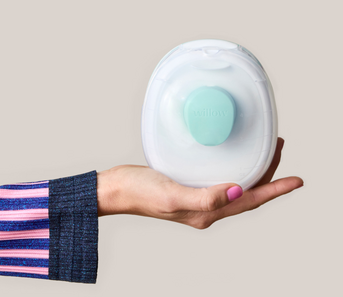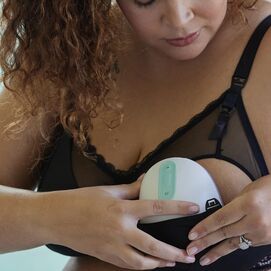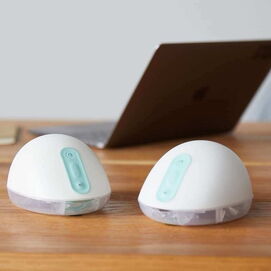Bringing your baby home for the first time is incredibly exciting. From nap times to belly crawls, there are so many milestones ahead to look forward to, one of them being breastfeeding!
Breastfeeding can be a challenge, and it may take some time to help your baby find an effective latching technique. If you are experiencing some pain while breastfeeding, a shallow latch may be the cause. Teaching your baby to find a deep latch is a crucial part of the breastfeeding experience, both for the efficiency of feeding and your overall wellbeing.
Learn how to get your baby to latch deeper with these guidelines. With time, achieving a deep latch will become clockwork for you and your little one.
What Does a Deep Latch Feel Like?
As you and your baby get better at breastfeeding, a deep latch should feel like a deep, tugging sensation. Above all, a deep latch should be painless. Granted, some pain at the start of the latch is completely normal, especially during your first breastfeeding sessions.
Can a Good Latch Still Hurt?
For your first time breastfeeding, a good latch can still hurt at the beginning of your journey. This initial pain can often be the signs of minor breast swelling or engorgement as your milk supply comes in. As you begin breastfeeding, this "full" sensation should subside. If the pain lasts the entire feeding session, or is particularly sharp, this is a sign that the latch may be too shallow.
The pain you experience during breastfeeding should subside after a few days. If it continues longer than a week, or you experience other painful symptoms, visit your doctor to help find a solution.
Signs of a Good Latch
Wondering if your baby has a good latch? While all mama-baby duos are different, below are some of the most common signs of a successful latch while breastfeeding:
Gentle, pulling sensation
Breasts feel softer after feeding
Baby's top lip is flipped upwards
Audible swallowing sounds
Baby has as much areola in the mouth as possible
Baby shows healthy weight gain
Signs of a Bad Latch
If you're experiencing pain while breastfeeding, keep an eye out for these signs of a bad latch:
-
Cracked, bleeding nipples
-
Baby seems hungry after feeding
-
Clicking or smacking sound while feeding
-
Baby doesn't pucker-up when feeding
-
Baby lets go frequently when feeding
5 Tips for Getting a Deeper Latch
It's common for your little one to have a shallow latch while learning to breastfeed. In order for your baby to nurse effectively during each session, try out these tips to help your baby find a deeper latch:
-
Have Patience
Above all, have patience with yourself and your baby. We know this is easier said than done when you're up at 2 am with a hungry baby. Breastfeeding is a commitment, but all of the sleepless nights will be worth it when your baby achieves that perfect latch.
If your baby is having trouble latching, gently pull them away and try again. Pumping ahead of time and storing a couple bottles for days where your baby struggles to latch can help alleviate your hungry baby in the mean time.
-
Check Your Baby's Lip Position
Your baby's lips can be a tell-tale sign for a good or bad latch. Gently brush your baby's lips with your nipple to encourage them to pucker up. When your baby's top lip is flipped upward, this allows them to fit more of the areola in their mouth, which is important for a deep latch.
You can also help your baby open their mouth by playing a game of silly faces. Did you know babies learn to imitate faces at an early age? This is an opportunity to ask for help from your partner. Ask them to sit on the ground with your little one and practice "open mouth" faces!
-
Apply Pressure to Baby's Back
When guiding your baby to your breast, apply firm pressure to their back to encourage them to sit in an upright position. While you should not force your baby onto your breast, you can apply as much pressure as needed to keep them facing your breast.
If your baby is having trouble feeding from an upright position, you may try the laid back method. This position is perfect for encouraging your baby to use their breastfeeding instincts. Plus, the laid back position allows you to create more skin-to-skin contact with your little one, which means more cuddles!
-
Hold Your Breast in a C Shape
Sometimes additional support for your breast is needed while breastfeeding. Use your free hand to hold your breast in a C shape so that it is propped up for your baby. While this hold helps guide your breast to your baby's mouth, it can also give you more control over the mobility of your breast. This helps to ensure that your breast is in the right position for your baby to find a deeper latch.
-
Tip Baby's Head Backwards
To achieve a deep latch, your baby's head needs to be tipped back so that their mouth can open as wide as possible. Your baby's chin should rest firmly against your breast while nursing, with their eyes and nose pointed upwards. If your little one's nose is digging into your breast, they will be unable to latch or swallow properly while feeding.
Remember that breastfeeding is something both you and your baby need to learn together. Finding a deep and efficient latch takes practices, but you will get there, mama! Have more breastfeeding or pumping questions? Visit the Willow blog to learn more.
Get pumping support with Simplifed
Get pumping support with Simplifed
Get access to free virtual feeding support from the lactation consultants at Simplifed. They can help you navigate supply issues, introduce a bottle, and more, and are trained on Willow pumps.














